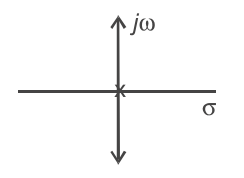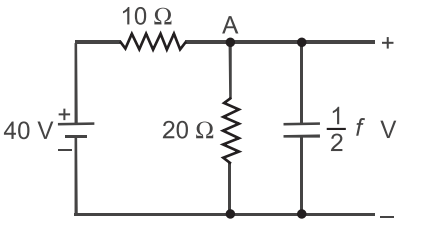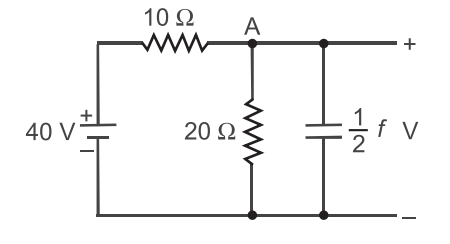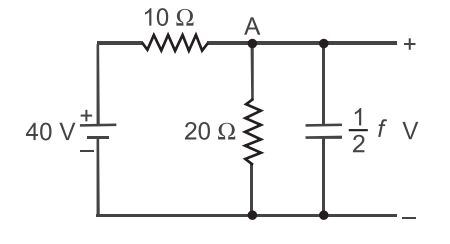Control systems miscellaneous
- A unity feedback system has an open loop transfer function, G(s) = K/s>sup>2. The root locus plot is—
-
View Hint View Answer Discuss in Forum
G(s) = K/s2
Angle of asymptote,φA = ± (2q + 1)180 2 – 0
where, q = 0, 1
when q = 0
φA = 90°
and when q = 1, φA = 270°
Hence root locus given in option (B) correct choice.
Correct Option: B
G(s) = K/s2
Angle of asymptote,φA = ± (2q + 1)180 2 – 0
where, q = 0, 1
when q = 0
φA = 90°
and when q = 1, φA = 270°
Hence root locus given in option (B) correct choice.
- A unity feedback system has open-loop T.F. is G(s) = {25/ [s (s + 6)]}. The peak overshoot in the step-input response of the system is approximately equal to—
-
View Hint View Answer Discuss in Forum
Given G(s) = 25 , H(s) = 1 s(s + 6)
the C.E. = 1 + G(s) H(s) = 0
= 1 + 25/s(s + 6) · 1 = 0
= s2 + 6s + 25 = 0
Here, ω2n = 25
⇒ ωn = ± 5
2ξωn = 6
or ξ = 6/2 × 5 = ·6
Now,% maximum overshoot, MP
e-πξ/√1-(0.6)2×100
e-0.6π/√1-(0.6)2×100
= 10%Correct Option: B
Given G(s) = 25 , H(s) = 1 s(s + 6)
the C.E. = 1 + G(s) H(s) = 0
= 1 + 25/s(s + 6) · 1 = 0
= s2 + 6s + 25 = 0
Here, ω2n = 25
⇒ ωn = ± 5
2ξωn = 6
or ξ = 6/2 × 5 = ·6
Now,% maximum overshoot, MP
e-πξ/√1-(0.6)2×100
e-0.6π/√1-(0.6)2×100
= 10%
- The maximum phase shift that can be obtained by using a lead compensator with transfer function
G(s) = (1 + 0.15s) (1 + 0.05s)
is equal to—
-
View Hint View Answer Discuss in Forum
Given, G(s) = (1 + 0·15s) ......…(i) (1 + 0·05s)
In phase lead compensation.Given, G(s) = V0(s) = (1 + sT) ......…(ii) Vi(s) (1 + sαT)
on comparing equations (i) and (ii), we have
T = 0·15
αT = 0·05
or
α = 0·05/0·15 = 1/3
Now,sin φm = 1 – α 1 + α
where, φm is the maximum phase shift angle
orsin φm = 1 – (1/3) 1 + (1/3)
or
sin φm = 2/4 = 1/2
or
φm = sin–1 (1/2) = 30°
Hence alternative (B) is the correct choice.Correct Option: B
Given, G(s) = (1 + 0·15s) ......…(i) (1 + 0·05s)
In phase lead compensation.Given, G(s) = V0(s) = (1 + sT) ......…(ii) Vi(s) (1 + sαT)
on comparing equations (i) and (ii), we have
T = 0·15
αT = 0·05
or
α = 0·05/0·15 = 1/3
Now,sin φm = 1 – α 1 + α
where, φm is the maximum phase shift angle
orsin φm = 1 – (1/3) 1 + (1/3)
or
sin φm = 2/4 = 1/2
or
φm = sin–1 (1/2) = 30°
Hence alternative (B) is the correct choice.
- In the network shown in the given figure. If the voltage V at the time considered is 20 V, then dV/dt at that time will be—

-
View Hint View Answer Discuss in Forum
From figure, the current through
20Ω resistor = 20/20 = 1A.
current through 10Ω resistor
= 40 – 20/10 = 2A.
By applying KCL at point A, current in the capacitor, say
i = 2 – 1 = 1A.
As we know that current across capacitor is given by relation
i = C dV dt i = 1 dV 2 dt
oror dV = 2V/s dt 
Correct Option: B
From figure, the current through
20Ω resistor = 20/20 = 1A.
current through 10Ω resistor
= 40 – 20/10 = 2A.
By applying KCL at point A, current in the capacitor, say
i = 2 – 1 = 1A.
As we know that current across capacitor is given by relation
i = C dV dt i = 1 dV 2 dt
oror dV = 2V/s dt 
- If the unit step response of a network is (1 – e–αt), then its unit impulse response will be—
-
View Hint View Answer Discuss in Forum
Given the unit step response is 1– e–αt, means
If r(t) = u(t)
then
R(s) = 1/s
y(t) = 1 – e–αt then
Y(s) = 1/s – 1/s + α = α/s(s + α)
Therefore, the transfer function of the system,H(s) = Y(s) R(s) = Y(s) s(s + α) 1/s = α s + α
Now, for input, r(t) = δ (t)
i.e., R(s) = 1
Y(s) = H(s) R(s)
orY(s) = α ·1 s + α
or
Y(t) = α·e–αt
Alternative method: Unit impulse response of a linear, time invariant network is the derivative of unit step function response of the network. Unit step response is (1 – e–αt)
∴ Unit impulse response is – (– α) e–αt = αe–αtCorrect Option: A
Given the unit step response is 1– e–αt, means
If r(t) = u(t)
then
R(s) = 1/s
y(t) = 1 – e–αt then
Y(s) = 1/s – 1/s + α = α/s(s + α)
Therefore, the transfer function of the system,H(s) = Y(s) R(s) = Y(s) s(s + α) 1/s = α s + α
Now, for input, r(t) = δ (t)
i.e., R(s) = 1
Y(s) = H(s) R(s)
orY(s) = α ·1 s + α
or
Y(t) = α·e–αt
Alternative method: Unit impulse response of a linear, time invariant network is the derivative of unit step function response of the network. Unit step response is (1 – e–αt)
∴ Unit impulse response is – (– α) e–αt = αe–αt

